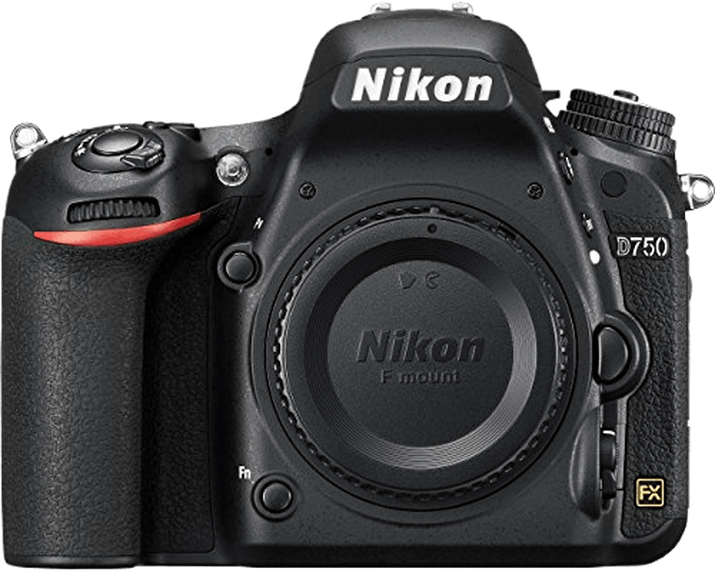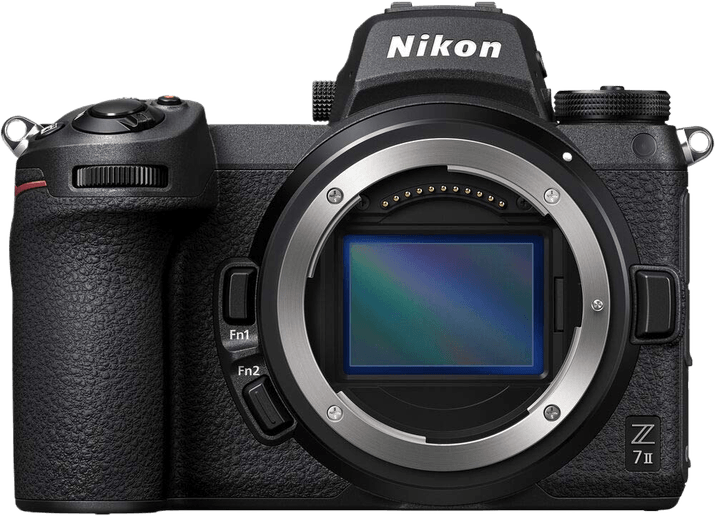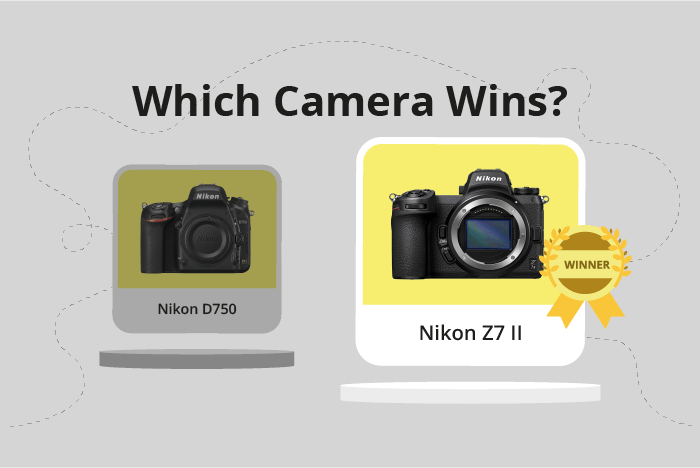Nikon D750 vs Z7 II Comparison
Nikon D750

Nikon Z7 II

The Nikon Z7 II takes the lead with a score of 85/100, outperforming the Nikon D750‘s 68/100. Both cameras share some general specifications, such as being released by the same manufacturer, Nikon. The D750, a DSLR camera, was launched in 2014 at a price of $2300, while the Z7 II, a mirrorless camera, was released in 2020 with a price tag of $3399.
The Nikon Z7 II excels with its smaller size and lighter weight, measuring 134 x 101 x 70mm and weighing 705g. In contrast, the Nikon D750 measures 141 x 113 x 78mm and weighs 750g. The Z7 II’s higher score indicates its superior performance and features compared to the D750.
However, the Nikon D750 has a lower launch price, making it a more budget-friendly option for those looking to save on their camera purchase. After comparing these points, it’s clear that the Nikon Z7 II offers better performance and portability, while the Nikon D750 provides a more affordable option for Nikon enthusiasts.
Nikon D750 vs Z7 II Overview and Optics
The Nikon Z7 II outperforms the Nikon D750 in optics, scoring 86/100 compared to the D750’s 71/100. Both cameras share some specifications, including a CMOS sensor, full-frame sensor size, and the ability to use Nikon lenses with their respective lens mounts (Nikon F FX for the D750 and Nikon Z for the Z7 II).
The Nikon Z7 II excels with its higher megapixel count of 45.75, which contributes to capturing more detail in images. It also boasts a faster shooting speed of 10 frames per second, making it suitable for capturing fast-moving subjects. The Z7 II’s dual Expeed 6 processors ensure efficient performance, while its DXOMARK sensor score of 100 signifies excellent image quality. Furthermore, the Z7 II features image stabilization, which helps reduce camera shake and produce sharper images.
On the other hand, the Nikon D750 has a lower megapixel count of 24.3, resulting in less detailed images. Its shooting speed of 6.5 frames per second is slower than the Z7 II, which may limit its ability to capture fast action. The D750’s Expeed 4 processor is less advanced compared to the Z7 II’s dual Expeed 6, and its DXOMARK sensor score of 93 is lower. Additionally, the D750 lacks image stabilization, making it more challenging to capture sharp images in certain conditions.
In terms of optics, the Nikon Z7 II is the superior choice due to its higher megapixel count, faster shooting speed, better processor, higher DXOMARK sensor score, and the presence of image stabilization. While the Nikon D750 shares some specifications with the Z7 II, it falls short in the areas that significantly impact image quality and performance.
Nikon D750 vs Z7 II Video Performance
The Nikon Z7 II outperforms the Nikon D750 in video capabilities, scoring 91/100 compared to the D750’s 56/100. Both cameras share some common specs, but the Z7 II has significant advantages in key areas.
Both the Nikon D750 and Z7 II offer video recording, with the D750’s maximum resolution being Full HD (1920×1080) and the Z7 II’s maximum resolution reaching 4K (3840×2160). The Z7 II’s higher resolution provides significantly more detail in recorded footage, making it the superior choice for those who prioritize video quality. Additionally, the Z7 II boasts a maximum video frame rate of 120fps, double the D750’s 60fps. This allows for smoother and more detailed slow-motion video capture.
Another advantage the Nikon Z7 II holds over the D750 is its built-in time-lapse functionality. This feature simplifies the process of creating time-lapse videos and adds versatility to the camera’s capabilities.
While the Nikon D750 does not surpass the Z7 II in any specific video-related aspect, it still offers respectable Full HD video recording at 60fps. This could be sufficient for casual users or those who do not require the highest possible video quality.
Comparing the video capabilities of the Nikon D750 and Z7 II, it is clear that the Z7 II is the superior choice for those seeking high-quality video recording. With its 4K resolution, 120fps frame rate, and built-in time-lapse functionality, the Z7 II offers a comprehensive and versatile video experience. Meanwhile, the D750 provides a more basic video offering, suitable for those with less demanding video needs.
Nikon D750 vs Z7 II Features and Benefits
The Nikon Z7 II outperforms the Nikon D750 in features, scoring 87/100 compared to the D750’s 59/100. Both cameras share some specifications, including a 3.2-inch screen, flip screen capabilities, and Wi-Fi connectivity. However, the Nikon Z7 II surpasses the D750 in other aspects, making it the superior choice in terms of features.
The Nikon Z7 II boasts a higher screen resolution of 2,100,000 dots compared to the D750’s 1,229,000 dots. This results in a sharper and clearer display for the Z7 II, providing users with a better image preview. Additionally, the Z7 II includes a touchscreen, which the D750 lacks. This feature allows for easier navigation and control of the camera settings.
Another advantage of the Nikon Z7 II over the D750 is Bluetooth connectivity. This feature allows for seamless file transfer and remote control of the camera, enhancing the overall user experience.
The Nikon D750, on the other hand, does not have any specific advantages over the Z7 II in terms of features. Both cameras lack GPS functionality, but this is the only common drawback.
In terms of features, the Nikon Z7 II is the clear winner. With a higher screen resolution, touchscreen capabilities, and Bluetooth connectivity, it provides users with a more advanced and user-friendly experience compared to the Nikon D750. While the D750 is still a solid camera, the Z7 II’s superior features make it a better choice for photographers seeking advanced technology and convenience.
Nikon D750 vs Z7 II Storage and Battery
The Nikon D750 triumphs over the Nikon Z7 II in storage and battery with a score of 79/100, compared to the Z7 II’s 71/100. Both cameras share two memory card slots, accepting SD cards. However, the Z7 II also supports CFexpress Type B/XQD (UHS-II compatible) cards, giving it an edge in versatility.
The D750 outperforms the Z7 II in battery life, offering 1230 shots per charge, while the Z7 II only provides 420 shots. Both cameras use EN-EL15 batteries, but the Z7 II utilizes the upgraded EN-EL15c version. Despite a shorter battery life, the Z7 II benefits from USB charging capabilities, which the D750 lacks.
Considering these factors, the Nikon D750 stands out in battery life, making it a reliable choice for prolonged shooting sessions. On the other hand, the Nikon Z7 II offers more storage options and the convenience of USB charging, which may appeal to users with diverse storage needs and on-the-go charging requirements.
Nikon D750 vs Z7 II – Our Verdict
Are you still undecided about which camera is right for you? Have a look at these popular comparisons that feature the Nikon D750 or the Nikon Z7 II:

